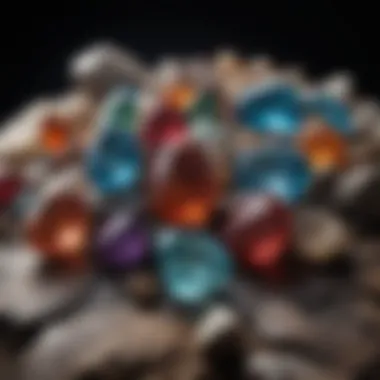Optimal Gemstones for Tumbling: A Comprehensive Guide


Intro
The world of gemstones and tumbling offers a unique intersection of art, science, and craftsmanship. Tumbling gemstones is not just a hobby; it is a meticulous process that can transform rough stones into polished masterpieces. However, not all gemstones are suitable for this process. Understanding their characteristics, such as hardness, texture, and durability, is critical for enthusiasts looking to achieve optimal results. This article will delve into the essentials, covering the historical significance of gemstones, their identification, classification, and the best practices to enhance tumbling outcomes.
History and Origins
Overview of Collectibles, Rocks, and Fossils
The practice of collecting gemstones and minerals has roots that extend back to ancient civilizations. Both rocks and fossils have been valued for their aesthetic beauty and metaphysical properties. In many cultures, gemstones were thought to bestow protection, prosperity, and health. Precious stones, such as diamonds and emeralds, were often reserved for royalty or the elite.
As the interest in natural history grew during the Renaissance, so did the appreciation for fossils and geology. Many collectors began to explore local quarries and riverbeds, creating personal collections that reflected their journeys. Today, this tradition continues, with amateur and professional collectors alike discovering the joys of gemstones and fossils.
Historical Significance and Cultural Impact
Gemstones have always held a place of cultural importance. Many religions and belief systems attribute symbolic meaning to specific stones. For instance, ancient Egyptians revered turquoise and lapis lazuli, incorporating them into jewelry and burial artifacts. Similarly, in Eastern cultures, jade is a stone associated with purity and serenity.
Moreover, gemstones have influenced art and design throughout history. They have adorned crowns, artworks, and even architectural features in significant historical buildings. Understanding their historical significance helps collectors appreciate the depth of the stones they tumble.
Identification and Classification
Guide to Identifying Rocks and Fossils
Identifying gemstones requires an understanding of their unique properties. Some key features include color, luster, and crystal structure. For those new to the field, a simple guide includes:
- Color: Identify the gemstone’s dominant color and any distinguishing markings.
- Hardness: Use the Mohs scale to assess the hardness. Softer stones may not withstand tumbling.
- Luster: Examine how light reflects off the surface. Common types include vitreous and pearly.
- Formation: Understand where the stone comes from. Different geographical locations yield different types of gemstones.
Common Types and Variations
Many gemstones yield excellent results when tumbled. Some notable mentions include:
- Agate: Known for its vibrant colors and patterns, agate is a favorite for tumbling. It has moderate hardness, making it suitable for beginners.
- Jasper: A variety of chalcedony, jasper is durable and exhibits unique designs, making it visually appealing.
- Quartz: Clear quartz is among the hardest gemstones, ensuring longevity through the tumbling process. Its versatility makes it a staple for collectors.
- Lapis Lazuli: This semi-precious stone is known for its deep blue color, requiring careful tumbling due to its softer nature.
Remember: Choosing the right gemstone initially can prevent loss of materials and ensure satisfaction in your finished projects.
Preamble to Tumbling Gemstones
The tumbling process polishes stones, rounding edges and creating a smooth finish. However, not all gemstones possess the necessary qualities for successful tumbling. Factors such as hardness, texture, and durability play critical roles. Choosing suitable stones facilitates efficient tumbling and enhances the aesthetic appeal of formed finishes.
Understanding the Tumbling Process
Tumbling is a method used to polish gemstones through mechanical abrasion. The process typically involves placing stones in a rotating barrel with abrasive materials. This action results in the gentle degradation of rough surfaces into polished smoothness. The tumbling action creates a uniform shape and shine. However, it is important to monitor the progress closely. Over-tumbling can lead to undesired results, such as excessive wear or loss of distinctive characteristics.
A standard tumbling cycle includes several stages: coarse grinding, medium grinding, fine grinding, and polishing. Each stage utilizes progressively finer abrasives. It is essential to clean the stones between these stages to avoid cross-contamination. Proper selection of grit and duration is also a crucial part of this process.
Importance of Choosing the Right Gemstones
The choice of gemstone is essential for successful tumbling. Selecting stones that are too soft can result in poor outcomes and unrefined surfaces. The hardness of a gemstone is measured on the Mohs scale. This scale ranges from talc at 1 to diamond at 10. For effective tumbling, stones should ideally range from 5 to 8 on this scale. Some common examples include:


- Agate
- Jasper
- Quartz
Additionally, the durability of a gemstone impacts its suitability for tumbling. Tough stones withstand the mechanical forces of tumbling better than brittle ones. Ignoring these properties can lead to chipped, cracked, or even broken gemstones. Therefore, understanding the inherent characteristics of each gemstone type is not merely beneficial but necessary.
Choosing the right gemstones aids in achieving the desired finish while preserving their natural beauty. This attention to detail ultimately enriches the tumbling experience.
Essential Factors in Selecting Gemstones
Hardness and Mohs Scale
For example, gemstones like agate and quartz, which rate around 7, are excellent candidates. They offer strength and resilience during the tumbling process. Conversely, softer stones, such as calcite, which has a hardness of about 3, tend to wear down quickly, making them unsuitable for prolonged tumbling.
Durability and Toughness
Durability and toughness are also critical factors in gemstone selection. While hardness addresses scratch resistance, durability refers to how well a gemstone can withstand various environmental conditions. Toughness combines these attributes, reflecting the stone’s overall ability to resist breaking or chipping.
Some gemstones are known for their toughness. Jasper, for instance, is both hard and durable, making it ideal for tumbling. In contrast, stones like opal, which may appear visually appealing but lack toughness, can easily fracture under stress. It is essential to assess the durability of each gemstone to ensure that the tumbling process will not diminish their natural beauty.
Shape and Size Considerations
The shape and size of the gemstones influence the tumbling process significantly. Irregularly shaped stones may tumble unevenly, leading to inconsistent results. Ideally, selecting stones that are relatively uniform in shape can yield better results. This uniformity helps ensure that all stones in the tumbler receive similar treatment during the process.
Size also matters, as larger stones take longer to tumble and require more energy. When beginning with a batch of unevenly sized stones, it may be advisable to group them by size. This practice will ensure that tumbling proceeds efficiently and effectively, resulting in a consistent finish on your gemstones.
Always consider the compatibility of stone shapes and sizes in your tumbler for optimal results.
Agate
Color Varieties
Agate offers a fascinating range of colors and patterns, which contributes greatly to its popularity. The variety is expansive, leading to unique designs in each piece. Some common colors include blue, red, green, and brown. The appeal of these colors is their ability to attract collectors and hobbyists alike. Choosing agate means having a high chance to create striking, visually appealing stones.
Tumbling Characteristics
Agate is known for its ability to withstand the tumbling process effectively. Its hardness, rated between 6.5 and 7 on the Mohs scale, ensures longevity during the tumbling phase. This gemstone typically produces smooth, shiny finishes with relative ease. However, care must be taken with softer agate varieties, as they might yield less satisfactory results if taken for granted.
Jasper
Types of Jasper
Jasper presents an intriguing diversity in its types, each displaying their specific colors and patterns. This variety enhances its appeal within the tumbling community. Some well-known types include Picture Jasper, Brecciated Jasper, and Red Jasper. Each offers unique aesthetics, making them favored choices for tumbling. Collectors appreciate the individuality in designs that different jaspers can offer.
Practical Tips for Tumbling
When tumbling jasper, it is essential to follow certain practical steps. Each type may respond differently to the tumbling process. Smoother pieces usually yield better results compared to rough, jagged stones. Start with coarse grit and move progressively to finer grits. Doing so allows dense jaspers to become polished without sustaining damage.
Quartz


Clear Quartz
Clear Quartz is one of the most versatile gemstones available for tumbling. Its hardness and lack of natural flaws make it ideal for novice tumblers. The clarity of clear quartz means the final product presents a beautiful, shining stone. Additionally, its prevalence means it is often readily available and economical for tumblers.
Rose Quartz and Others
Rose Quartz adds a soft, appealing hue to any collection. Its unique pink color and properties regarding healing make it popular among hobbyists. However, it has a slightly lower hardness compared to clear quartz. Careful handling during the tumbling process is needed to avoid scratches and pits. Other variations of quartz, such as amethyst and citrine, also offer distinct colors and patterns but share similar characteristics.
Calcite
Varieties and Uses
Calcite is known for its vast range of varieties, including Iceland Spar, Honey Calcite, and more. The diversity makes it an exciting option for collectors. However, calcite's softness, ranking 3 on the Mohs scale, means it requires careful tumbling techniques. It provides an opportunity for learning, as tumblers need to adjust methods to suit this gem's fragility.
Tumbling Challenges
The challenges with calcite usually arise from its softness. It can easily scratch and wear down if improper grit and duration of tumble are applied. Thru this, hobbyists can learn patience and attention to detail. Ensuring the right mix of stones can help mitigate these risks and provide successful tumbling experiences.
Serpentine
Properties and Appearance
Serpentine possesses striking green shades and often features interesting patterns. Its unique appearance enhances its desirability. It typically has a hardness rating of 2.5 to 4.5, which is softer than many gemstones. This softness means that extra care is essential when tumbling to avoid damaging the stone.
Tumbling Methods
Using serpentine in tumbling requires specific methods. Starting with a gentle touch and moving to coarse grits can lead to better finishes. Additionally, ensuring that you tumble alongside tougher stones can minimize the risk of the serpentine becoming damaged. Understanding these methods fosters confidence in using serpentine, despite its challenges in the tumbling process.
In summary, choosing the right gemstones is pivotal in successful tumbling. Each type has its unique characteristics that can either complicate or enhance the tumbling experience.
Techniques for Tumbling Different Gemstones
Tumbling gemstones is an art and a science. Each gemstone has unique qualities that require specific approaches during the tumbling process. Understanding these techniques ensures not only the safety of the gemstones but also enhances the final outcome. This section focuses on the essential aspects of tumbling techniques tailored for different gemstones, highlighting basic steps, safety measures, and the art of grading and polishing.
Basic Tumbling Steps
The tumbling process consists of a series of straightforward steps that anyone can follow. Here is the general process:
- Selecting Gemstones: Start by choosing the right gemstones. Make sure they are compatible based on hardness and other factors.
- Preparing Gemstones: Clean the stones before tumbling. Remove dirt or oil, as it can affect the tumbling efficiency.
- Loading the Tumbler: Place the stones in the tumbler, ensuring not to overload it. This helps in even tumbling.
- Adding Grit: Choose the appropriate grit. Start with a coarser grit to shape the gems, then move to finer grit for polishing.
- Tumbling Duration: Set the tumbler to run for several days, depending on the grit and gemstone hardness. Monitor progress regularly.
- Cleaning and Inspecting: After the tumbling cycle, clean the gemstones and inspect them for the desired finish. Repeat tumbling if necessary.
Each step plays a vital role in achieving a well-rounded finish. Following these basic steps can significantly impact the overall results you achieve in your tumbling journey.
Safety Precautions
While tumbling gemstones is an engaging hobby, safety should always be a priority. Here are some essential safety precautions to consider:
- Protective Gear: Use safety goggles and gloves when handling tumblers and chemicals. This protects against dust that can be harmful.
- Ventilation: Ensure proper ventilation when operating a tumbler, especially if using grits or polishing agents that can produce inhalable dust.
- Electrical Safety: Check the tumbler’s electrical components regularly to prevent any risks of shock or fire.
- Handling Gemstones: Be careful while handling rough stones, as they can have sharp edges. Avoid injuries by using gloves.


Creating a safe tumbling environment not only protects you but also prolongs the life of your equipment. Remember, a few precautions can go a long way in ensuring a successful tumbling experience.
Grading and Polishing Techniques
After tumbling, grading and polishing your gemstones is crucial to showcase their beauty. Here are some key techniques:
- Grading System: Develop a grading system based on clarity, shape, and surface finish. Classifying your gems helps determine which require additional polishing.
- Polishing Agents: Utilize the correct polishing compounds. For example, cerium oxide works well for quartz-based stones, while aluminum oxide is suitable for harder gems.
- Timing and Pressure: During polishing, apply gentle pressure and time the process accurately for the best finish. Too much pressure can damage the stone.
"Finishing well is as important as starting with the right minerals."
- Regular Inspection: Inspect the gemstones frequently during the polishing phase. This allows for immediate adjustments if the desired shine is not achieved.
Practicing these grading and polishing techniques can elevate the overall quality of the gemstones you work on. Investing time here increases satisfaction with your tumbling projects.
Common Mistakes in Tumbling Gemstones
Tumbling gemstones can be a rewarding hobby, allowing collectors to transform rough stones into polished gems. However, the process is not without its challenges. Understanding the common mistakes in tumbling gemstones is vital for achieving optimal results, and it significantly helps in avoiding frustration. By recognizing these errors, hobbyists can increase their chances of creating beautiful finished products and make the most of their time and investments.
Overloading the Tumbler
One of the most frequent mistakes in gemstone tumbling is overloading the tumbler. Many enthusiasts may believe that filling the tumbler to its maximum capacity will save time by processing more stones at once. However, this approach can lead to several negative consequences.
- Reduced Effectiveness: An overloaded tumbler cannot move freely, which results in inadequate polishing.
- Damage to Stones: Excess stones might collide with one another and cause chips or breaks.
- Inefficient Use of Abrasives: Proper abrasive distribution might get compromised, slowing down the tumbling process.
To avoid this, always follow the manufacturer’s recommendations for load limits. A general rule is to fill the tumbler to about three-quarters of its capacity, ensuring space for movement and adequate contact between stones.
Inadequate Cleaning Before Tumbling
Cleaning gemstones before tumbling is an essential step that should never be overlooked. Stones can have dirt, oil, or other contaminants that interfere with the tumbling process. Inadequate cleaning can lead to:
- Dull Finish: Grime can scratch the surface, preventing the stone from achieving a smooth, polished look.
- Cross-Contamination: Different types of stones might react poorly if they're processed together without proper cleaning, affecting their appearance.
- Increased Wear on Tumbler: Additional debris can wear down the tumbler parts more quickly.
To ensure a successful tumbling process, rinse stones thoroughly under running water, removing any dirt or residues. An ultrasonic cleaner can also be a helpful tool for cleaning stubborn grime.
Ignoring Specific Gemstone Needs
Each gemstone possesses unique characteristics that determine how it should be tumbled. Ignoring specific gemstone needs can result in disappointing outcomes. Each type has its
- Hardness: Stones with lower hardness may not withstand extended tumbling, resulting in damage.
- Texture: Different surface textures affect how well stones polish and shape during tumbling.
- Fractures or Inclusions: Some stones are more fragile. Understanding their vulnerabilities is crucial.
Before beginning the tumbling process, research the gemstones you plan to tumble. Adjust your techniques and choose the right abrasives for each type to maximize your results.
Understanding these common mistakes will help tumbling enthusiasts to improve their skills gradually, leading to better results and a more enjoyable hobby.
Finale
Recap of Key Points
- Understanding the Tumbling Process: Knowing the basics of tumbling is essential before selecting any gemstones. This can help to avoid common pitfalls and to optimize results.
- Importance of Selecting the Right Gemstones: Different gemstones have unique properties. Selecting stones like Agate and Quartz often yields better results due to their durability and hardness.
- Avoiding Common Mistakes: Being mindful of frequent errors can save time and resources. Avoiding overloading or neglecting specific needs proves critical.
- Tumbling Techniques: Employing correct methods, as described, enhances the quality and luster of the stones.
When embarking on your tumbling journey, it’s advised to conduct thorough research. Look for specific traits such as hardness and fragility. Reading about other hobbyists’ experiences can also provide insights that enhance practice.
Ultimately, successfully tumbling gemstones adds value to your collection and enriches your knowledge in this fascinating hobby.
As you refine your selection skills, remember that each gemstone tells its own story, waiting to be unveiled through the tumbling process.



